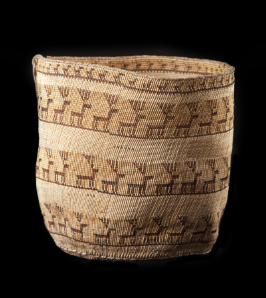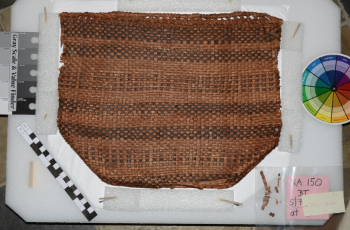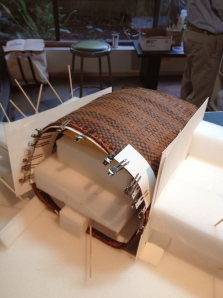Media Resources
Press Release
For immediate release: Oct. 23, 2013
Media contact: Andrea Foust
Membership and Public Relations Manager
Hallie Ford Museum of Art at Willamette University | 503-370-6867
Public contact: 503-370-6855 | museum-art@willamette.edu
New efforts preserve the museum's Native American basket collection
SALEM, Ore. — The Hallie Ford Museum of Art recently completed a major collections management initiative focused on the museum’s collection of over 350 Native American baskets. The project addressed issues of storage, conservation, cataloging, and access to the collections. With funding provided by Oregon Heritage Commission, Oregon Cultural Trust, and Siletz Tribal Charitable Contribution Fund, the museum built proper storage mounts, photographed all baskets in the collection; conducted a full conservation survey of the collection and treated 18 baskets (cleaning, reshaping, stabilizing, and repairing); gathered additional catalog information on over 100 baskets including cultural, technical, and material analysis; and uploaded all images and catalog information to a searchable online database.
The Hallie Ford Museum of Art has a strong collection of both traditional and contemporary baskets by Native American artists. The traditional art collection is focused on Northwest tribes with an emphasis on tribes from Oregon and more specifically the Willamette Valley. The earliest basket to enter Willamette University's collection includes a basket given in 1840 to Rev. J.L. Parrish, a missionary and founding trustee of the university. Many of the baskets in the collection were collected by Edwin C. Cross of Salem during the 1890s and early 1900s, and were later given to the university by his daughter, Veda Cross Byrd. Others were collected by E.M. Polleski around the same period.
Anthropology professor Rebecca Dobkins initiated an inventory of the collection in the fall of 1997, assisted by Willamette students and Yvonne Lever, a graduate student at the University of Oregon at the time. In the spring of 1998, Margaret Mathewson, a respected ethnobotanist and expert on Native American basketry examined the collection and made further identifications based on weaving techniques, designs, and materials of manufacture. In the twenty-first century, many Native American artists and Willamette students have worked with the collection for research and exhibition purposes.
###
About the Hallie Ford Museum of Art
Oregon's third largest art museum features works by Pacific Northwest and Native American artists, and includes a diverse collection of traditional European, American and Asian art, as well as artifacts that date from antiquity. Frequently changing exhibitions include lectures, special events, tours, artist demonstrations and educational opportunities for children and adults.
The museum is located at 700 State St. in Salem. Hours are Tuesday through Saturday from 10 a.m. to 5 p.m. and Sunday from 1 to 5 p.m. The galleries are closed on Monday. General admission is $6, $4 for seniors and $3 for students 18 and older. Students 17 and under and children are admitted free. Admission is free for everyone on Tuesdays. For more information call 503-370-6855 or visit willamette.edu/arts/hfma.
The searchable online database of Native American baskets at the Hallie Ford Museum of Art
High Resolution Photos for Media
Copyright Notice:
The following images posted on this page are for publicity purposes only, intended for use by journalists in media-related publications. Use of any image must be accompanied by its credit line. Use of these images by any other parties or for any other purposes, private or commercial, is strictly prohibited unless the express written consent is obtained directly from Hallie Ford Museum of Art. For information regarding educational, personal and commercial use of images, please visit our Copyrights & Reproductions page.
For assistance contact Andrea Foust 503-370-6867 or at afoust@willamette.edu.

To download: click on the image above to open the high resolution photo in a new window, then right-click and save.

Unknown artist, Basket, pre-1900, cedar bark (plain and mud-dyed), 12.25" x 9" x 7.5", the Edwin C. Cross Collection, gift of Veda Cross Byrd
Collection, Hallie Ford Museum of Art, NA 150.
Notes: This flattened cedar bark basket that is over 100 years old underwent conservation treatment with Tom Fuller.

Unknown artist, Basket, pre-1900, cedar bark (plain and mud-dyed), 12.25" x 9" x 7.5", the Edwin C. Cross Collection, gift of Veda Cross Byrd
Collection, Hallie Ford Museum of Art, NA 150.
Notes: This basket regained its three dimensional shape with Fuller's help.
Interviews
Interview opportunities:
- Jonathan Bucci, Project Manager, Collection Curator, Hallie Ford Museum of Art
- Rebecca Dobkins, Faculty Curator of Native American Art, Hallie Ford Museum of Art
- Tom Fuller, Northwest Objects Conservation, Inc.
- Margaret Mathewson, Native Basketry Consultant and Ethnobotanist
